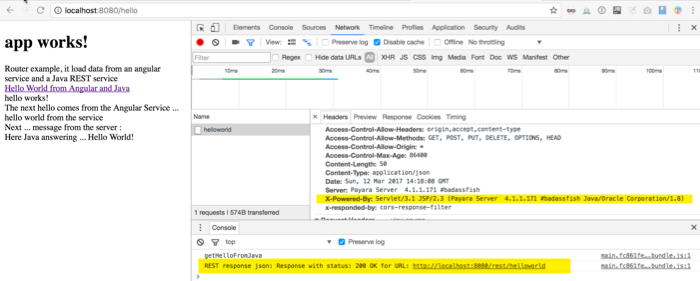

Angular CLI, Java EE and REST : tutorial and quick starter code for Hello World
source link: https://marco.dev/2017/03/12/angular-cli-java-ee-and-rest-tutorial-and-quick-starter-code-for-hello-world/
Go to the source link to view the article. You can view the picture content, updated content and better typesetting reading experience. If the link is broken, please click the button below to view the snapshot at that time.

java-version.com: What's new in Java 16? 15? Keep up to date!
Angular CLI, Java EE and REST : tutorial and quick starter code for Hello World
Complete Java EE and Angular example
New demo available here: https://javademo.io – https://github.com/marco76/java-demo – https://marco.dev/2017/04/06/java-angular-demo/
Problem we need a new web application that uses Java EE as backend and Angular as frontend. It should be easy to configure.
Solution you can find the code of the application here:
https://github.com/marco76/javaee-angular-starter The scope of the application is limited (1 angular route, 1 http service, only a JSON ressource), this allow you to start with a clean application. I will build another app to shows some other features.
Features
- frontend built and compatible with Angular CLI
- configured to use the development and production mode of WebPack
- ready to use out of the box
- build a WAR file compatible with Java EE servers (JBoss, Payara/Glassfish etc.)
- it comes with all the nice features of Angular CLI: tests, good practices etc.
- automatic deploy during the development
How to install
Prerequisites -you need maven, npm, git and an application server Java EE
Production mode
- clone the git project
- from the root of the project launch
mvn packagethis generates a package named ROOT.war in the PROJECT/server/target directory - you can deploy this package in your favourite application server. The Angular application should answer at the requests to https://localhost:8080
Development mode
- clone the git project
- You can start the server using your favourite IDE. The project uses a standard Maven directory structure. You need to configure the server to deploy the server.war artifact.
- from the PROJECT/client/src directory install the npm packages :
npm install - launch the client with
ng serve. The client uses the port 4200 (default for Angular CLI) and you can navigate to https://localhost:4200
The result

The result is not particularly fancy. It show the result of a call to a Java REST service … but hey, you have a ready to go configuration based on Java EE and Angular that follows the Angular best practices.
How it works As for the previous
Angular/Spring project we have a main maven project with 2 modules :
<modules>
<module>client</module>
<module>server</module>
</modules>
Client: contains the Angular project generated using Angular CLI (= top quality) Server: contains the Java EE project (very minimalistic, 1 REST service and 1 filter to avoid the CORS restrictions during the development). When we build the final package the angular project is build and the result saved in a directory that will be integrated in the Java EE build. During the development the two separate projects are deployed. For the production only 1 deployable war is generated. Here the details of the maven build phase:
<plugin>
<groupId>org.codehaus.mojo</groupId>
<artifactId>exec-maven-plugin</artifactId>
<version>1.5.0</version>
<executions>
<execution>
<id>install npm</id>
<configuration>
<workingDirectory>./src/</workingDirectory>
<executable>npm</executable>
<arguments>
<argument>install</argument>
</arguments>
</configuration>
<phase>generate-resources</phase>
<goals>
<goal>exec</goal>
</goals>
</execution>
<execution>
<id>build js</id>
<configuration>
<workingDirectory>./src</workingDirectory>
<executable>ng</executable>
<arguments>
<argument>build</argument>
<argument>--target=production</argument>
<argument>--environment=prod</argument>
</arguments>
</configuration>
<phase>generate-resources</phase>
<goals>
<goal>exec</goal>
</goals>
</execution>
</executions>
</plugin>
Author
Marco Molteni
Marco Molteni Blog
Recommend
About Joyk
Aggregate valuable and interesting links.
Joyk means Joy of geeK